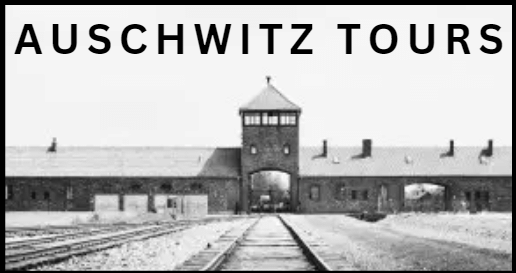Auschwitz Atrocities
Prisoners at Auschwitz were subjected to brutal forced labor in dangerous and exhausting conditions. Many worked in factories producing materials for the German war effort, while others were forced to carry out manual labor, including digging ditches and constructing buildings. The Nazis saw prisoners as a source of free labor and used them to produce goods and services for their war effort. Prisoners were often worked to the point of exhaustion and subjected to brutal punishments for failing to meet their daily quotas. The harsh conditions of forced labor were a key element in the systematic dehumanization and extermination of prisoners.
Also Read: About Auschwitz
Starvation was a key tool in the Nazis' system of extermination at Auschwitz. Prisoners were deliberately starved, often provided with insufficient food and water. The meager rations were intended to weaken the prisoners and make them more susceptible to disease and death. Many prisoners suffered from malnutrition and died of starvation, while others were subjected to cruel medical experiments testing the effects of starvation. The Nazis saw starvation as a way to hasten the extermination of prisoners, and the practice was part of their systematic attempt to dehumanize and eliminate those deemed undesirable.
Do Checkout: Auschwitz Tours
Medical experiments conducted at Auschwitz were cruel and often lethal. The Nazis used prisoners as human guinea pigs to test the effects of drugs, experiment with sterilization techniques, and conduct surgical procedures without anesthesia. These experiments were often conducted without regard for the prisoners' health or well-being, and many resulted in permanent disability or death. The Nazis justified these experiments as part of their efforts to promote the health and well-being of the "Aryan" race.
Must Read: Wieliczka Salt Mine
Upon arrival at Auschwitz, prisoners were subjected to selection processes where they were separated into groups to be either sent to forced labor or immediate extermination. Those selected for extermination were sent to the gas chambers. The selection process was brutal and often arbitrary, with prisoners deemed unfit for labor or considered a threat to the Nazi regime immediately condemned to death. This process was a key element in the systematic extermination of prisoners and was a testament to the inhumanity of the Nazi regime.
Suggested Read: Plan Your Visit to Auschwitz
Auschwitz gas chambers were a key element in the Nazi regime's system of extermination at Auschwitz. Prisoners selected for immediate extermination were sent to gas chambers and crematoria, where they were murdered en masse with the use of poisonous gas. The use of gas chambers was a chillingly efficient means of killing large numbers of people quickly and was a testament to the brutality of the Nazi regime.
Executions at Auschwitz were carried out in various ways, including by shooting, hanging, and lethal injection. These executions were often arbitrary and carried out as punishment for minor infractions, such as attempting to escape. The executions were a means of asserting the power of the Nazi regime and served as a constant reminder of the consequences of disobedience.
You May Also Like: Auschwitz History
Punishments at Auschwitz were brutal and included beatings, whippings, and torture. These punishments were often arbitrary and carried out as a means of asserting power and control over prisoners. Even minor infractions could result in severe punishment, and many prisoners died as a result of the brutal treatment they received.
Book Now: Wawel Castle Tickets
Medical neglect was rampant at Auschwitz, with prisoners receiving inadequate medical care and often dying from diseases and infections. The Nazis deliberately withheld medical treatment from prisoners, using disease and infection as a means of hastening the extermination process. Medical neglect was a key element in the systematic dehumanization and extermination of prisoners.
Also Read: Things to Do in Auschwitz
The living conditions at Auschwitz were inhumane, with prisoners housed in cramped and unsanitary barracks. They were often forced to sleep on the floor with no blankets or bedding, and many suffered from exposure to the elements. The lack of basic sanitation and hygiene led to the spread of disease and infection, and many prisoners died as a result of the deplorable living conditions.
Must Read: Things to Know Before Visiting Auschwitz
FAQs
What types of atrocities were committed in Auschwitz?
Prisoners in Auschwitz were subjected to forced labor, starvation, medical experiments, and brutal punishments. Many were also subjected to gas chambers and mass executions.
Checkout & Book: Oskar Schindler's Enamel Factory Tickets
Who was responsible for the atrocities in Auschwitz?
The Nazi regime under the leadership of Adolf Hitler was responsible for the atrocities committed in Auschwitz and other concentration camps during the Holocaust.
What happened to the surviving prisoners of Auschwitz?
Many survivors of Auschwitz were severely traumatized and physically debilitated. Some were able to rebuild their lives, but many struggled with ongoing physical and emotional effects from their experiences.
Suggested Read: Liberation of Auschwitz
Why Auschwitz is so famous?
Auschwitz is famous because it was one of the largest and deadliest Nazi concentration camps during the Holocaust. It is estimated that over 1.1 million people were killed at Auschwitz, including Jews, Roma, Soviet prisoners of war, and others deemed undesirable by the Nazi regime. The horrors that took place at Auschwitz have become a symbol of the atrocities committed by the Nazis during World War II.
What is the best time to visit Auschwitz?
The best time to visit Auschwitz depends on personal preferences, but it is generally recommended to visit during the off-season (October to March) to avoid crowds and long lines. However, it is important to note that winter temperatures can be very cold, so visitors should dress warmly.

